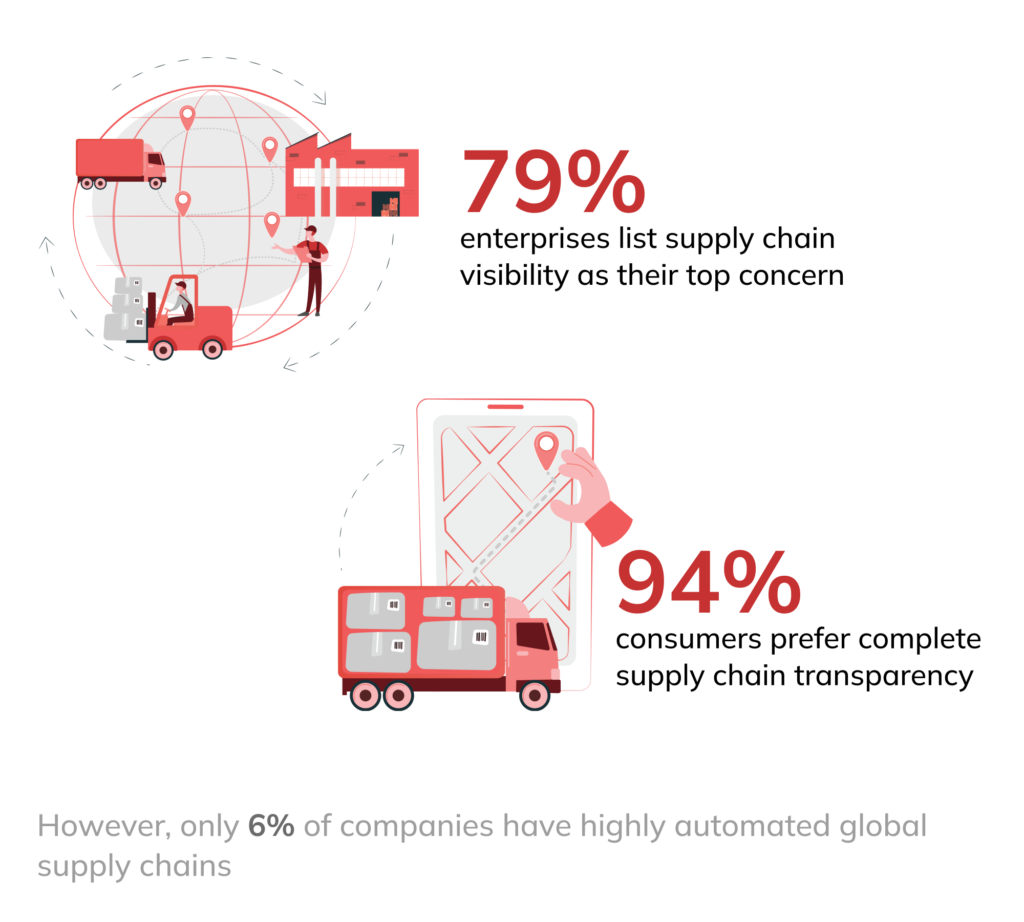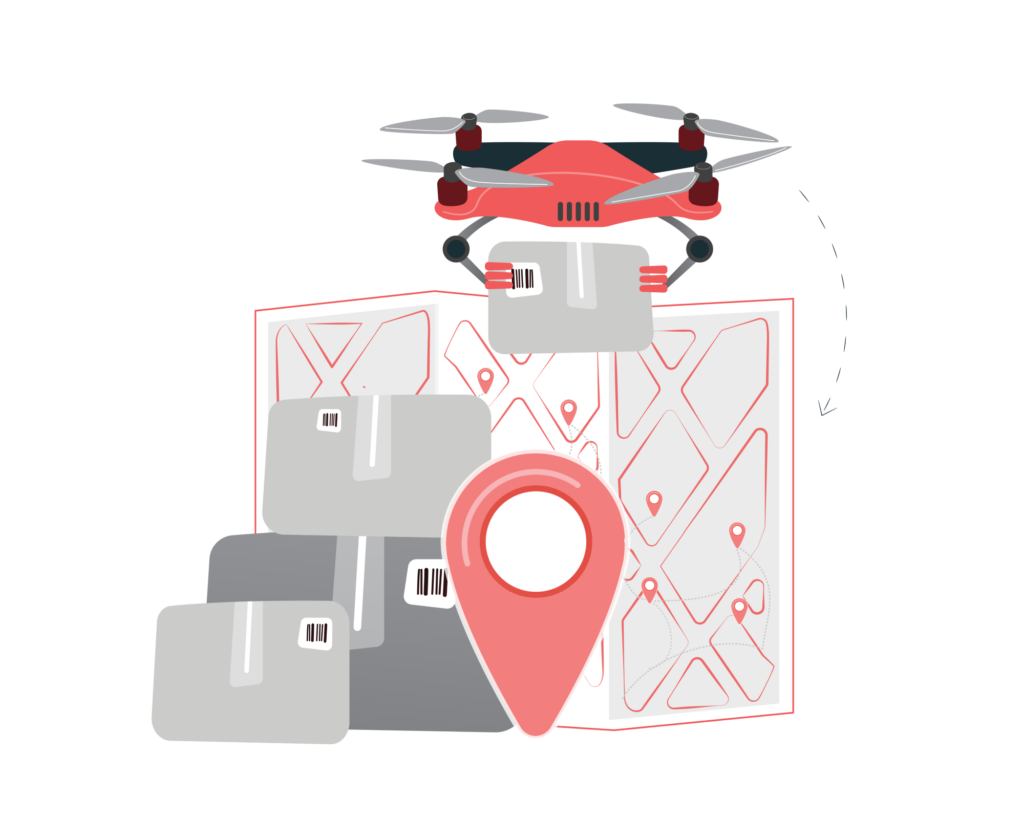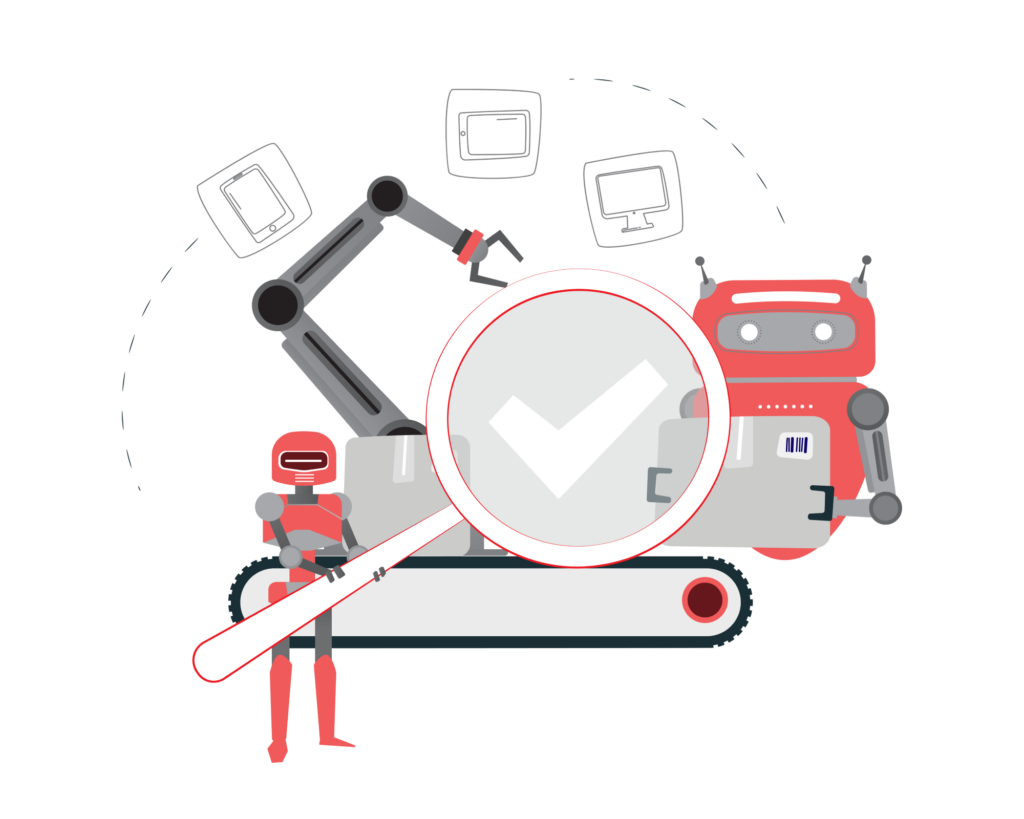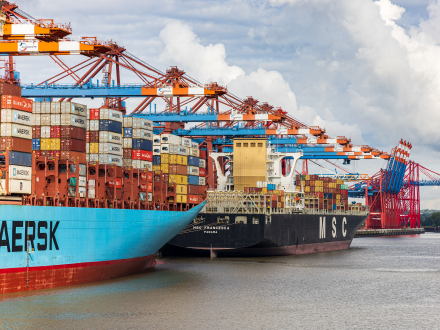Your message has been sent.
We’ll process your request and contact you back as soon as possible.
The form has been successfully submitted.
Please find further information in your mailbox.




Logistics is plagued by inefficient workflows and fragmentation.
Relying on robotic process automation, you can optimize your operation and make it more resilient to volatile delivery conditions.

Global transportation costs have been steadily increasing in recent years, leading to volatility in fuel prices. As a result, trucking companies predict double-digit annual contract rate increases due to strained capacity. Moreover, there is a severe shortage of approximately 400,000 vehicle drivers and truckers in Europe, resulting in transportation disruptions and a shortage of supplies. Logistics companies are also facing input cost increases and increased spending on freight, with road transportation rates rising by 23%.
Although IoT has many advantages, numerous brands still rely on manual tracking. This practice involves utilizing spreadsheets and numerous software applications for the same task, hindering workforce productivity and efficiency.
Due to today’s globalized economy, customers expect real-time visibility into their purchases, expecting them to be delivered quickly and cost-effectively. However, the lack of transparency throughout the supply chain can impede the goods flow and hamper logistics.
The logistics supply chain encompasses the production of goods from the manufacturing stage until their delivery to the customer. Due to the lack of an integrated communication system, original equipment manufacturers frequently face challenges. This inadequacy results in disjointed communication, leading to a negative impact on delivery timelines and operational effectiveness.
For several years, empty or non-revenue miles have been a persistent issue in the logistics industry since shippers and carriers suffer from mileage accumulated while driving an empty container, resulting in unwarranted cost increases, harmful environmental consequences, and diminished efficiency.
The devastating impact of the COVID-19 pandemic has led to the closure of many contractors, which has resulted in a range of labor-related challenges in the shipment and warehousing industries. For instance, the shortage of chips has significantly delayed smartphone shipments, resulting in postponed product launches and lengthy wait times for individuals who pre-ordered digital devices.
To address the transportation challenges and redefine logistic workflows, companies should adopt the best RPA practices. Today, organizations implement this powerful technology in logistics to enhance shipment management from fulfillment centers to purchasers.

Through their accounts, customers can track the location and movement of their goods, including expected arrival time and shipping delays. With RPA, companies can automate inbound checks, saving time and resources and ensuring customers receive deliveries requiring a signature or packages that should not be left unattended. Additionally, businesses automate customer and vendor interactions by reading and responding to IVR or email interactions, resulting in efficient and accurate product shipping.
Additionally, RPA in logistics facilitates disruption management, adjusting processes automatically in response to changes, notifying relevant parties when issues arise, providing details, and suggesting rectifying actions. By automating these processes, employees can work more effectively, allowing businesses to accomplish more with the same number of employees.
By optimizing freight orders to the most appropriate fulfillment center, RPA ensures prompt delivery to customers. The automated processes of RPA integrate various systems across the entire fulfillment chain, resulting in optimal supply efficiencies that cannot be achieved with on-premise solutions alone. Ultimately, standard and repetitive routines, such as order routing, benefit the most from RPA in logistics as decision-makers free up resources to concentrate on more complicated and resource-demanding tasks.
Drivers and supply chain participants need automated reporting data to focus their efforts and better comprehend delivery terms. Through task automation, freight can move smoothly through the supply network and meet everyone’s requirements, ensuring end-to-end visibility and predictability. Furthermore, swift reporting and integrated analytics can decrease confusion, enable managers to concentrate on their core competencies, and enhance processes consistently.
Without transparency, automated processes, and reliable data insights, organizations may struggle to make informed decisions. By implementing effective RPA technology in transportation, businesses can improve the quality and efficiency of customer services, keep contractors informed about supply chain operations, and adapt the system automatically to disruptions.
Ultimately, automated shipping and transportation can significantly impact a business’s ability to establish customer confidence and break down information silos across various departments.
Incorporating automation in the appropriate transportation processes can significantly enhance a company’s competitive edge through timely updates and inventory upkeep. With RPA technology, logistics and transportation practices can achieve effective inventory management and outperform competitors by transforming reordering and procurement into virtual operations.
RPA offers a range of benefits to logistics service providers, streamlining freight transportation, improving delivery accuracy, reducing overall costs, enhancing visibility, and providing enhanced customer service.

By selecting the most effective RPA processes, shipment tracking, and scheduling become effortless. Through automated tasks, managers can request shipment status updates and reports and internal access portals for more detailed information. Additionally, robotic process automation streamlines the review of shipment details such as incoming emails, logging tasks, and providing customers with accurate pick-up times.
With RPA, it is possible to automate the extraction of relevant information from invoices, such as the vendor’s name, invoice number, due date, and amount owed. Automation reduces the need for manual data entry, eliminating the need for time-consuming and error-prone operations. Also, RPA helps match invoices to purchase orders and receipts, flags any discrepancies for review, and ensures that invoices are processed accurately and efficiently.
RPA can automate the process of sending payment reminders and follow-up emails to customers and reduce the workload for credit collections teams, allowing them to focus on negotiating payment terms instead of repetitive tasks.
RPA bots are programmed to retrieve and process orders from multiple sources, such as email, websites, or electronic data interchange systems. They can extract the necessary information, such as product names, quantities, and delivery addresses, and input it into the company’s ERP or CRM system. RPA can also help with order validation and processing, ensuring that orders are accurate and processed quickly.
RPA can help with inventory management by automatically updating inventory levels, alerting when stock levels are low, and generating purchase orders when goods leftovers fall below a certain point.
RPA bots can be configured to extract relevant data from various sources, such as carrier websites, emails, and spreadsheets. For example, RPA can automatically capture information such as PRO numbers, track/trace details, invoice amounts, and delivery dates. Furthermore, this technology helps search for relevant information on the status of loads, delivery dates, and potential issues, such as delays or damages. In this way, any issues can be identified early, allowing for quicker resolutions and improved customer service.
In addition to automating email communication, RPA can be used to send out newsletters and updates to subscribers. By analyzing the content of emails, this disruptive technology automatically files them in relevant folders or escalates them to the appropriate employees.
To improve peer-to-peer communication, RPA can be used to develop chatbots that interact with customers and respond to common queries without human involvement. In most cases, chatbots handle multiple languages and offer 24/7 support, enhancing the customer experience.
From email or ERP, robotic process automation can perform purchase orders automatically, extracting vendor information, item descriptions, quantities, and pricing. Automation bots input this information into the company’s ERP software, streamlining the procurement process and reducing errors.
With RPA, managers can track inventory levels automatically, alerting them when stock levels drop below a certain threshold. Automation bots generate purchase orders or reorder items when inventory levels fall below a certain level, ensuring the company has adequate stock.
Today, RPA is reshaping industries, offering disruptive capabilities to improve operational excellence and minimize workforce expenses in logistics and transportation. By minimizing human error, RPA enhances shipping processing, fleet and inventory monitoring, customer communication management, and more. For businesses lacking automation to advance, Innowise can start a digital journey that produces tangible benefits.
In the transportation and logistics industry, RPA (Robotic Process Automation) plays the role of automating repetitive and time-consuming tasks such as data entry, invoice processing, and tracking shipments, thereby increasing efficiency and reducing the likelihood of human error.
RPA can streamline processes like order processing, inventory management, and customer service interactions, leading to faster turnaround times, reduced operational costs, and improved customer satisfaction through consistent and accurate data handling.
RPA challenges in logictics include the integration with existing legacy systems, managing the change in workforce dynamics, ensuring the scalability of RPA solutions, handling complex processes that require decision-making capabilities beyond the scope of RPA, and maintaining the security of sensitive data handled by RPA systems.
Rate this article:
4.8/5 (45 reviews)












Your message has been sent.
We’ll process your request and contact you back as soon as possible.

By signing up you agree to our Privacy Policy, including the use of cookies and transfer of your personal information.